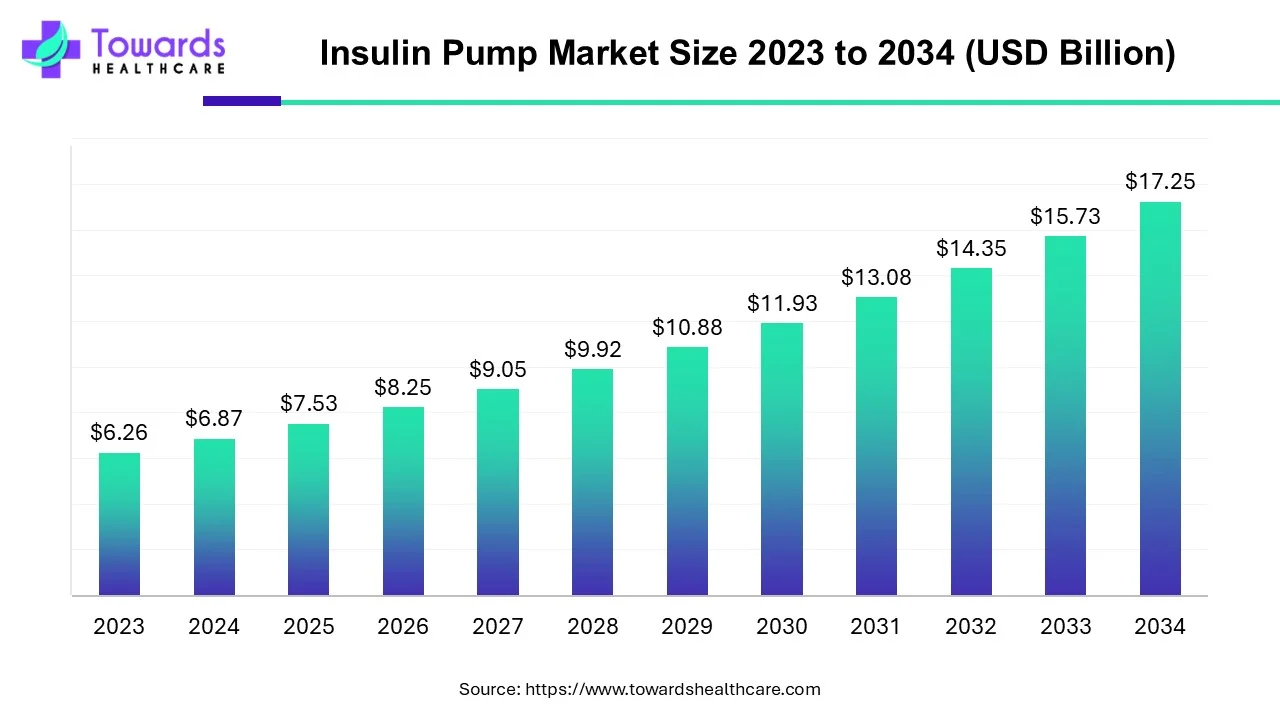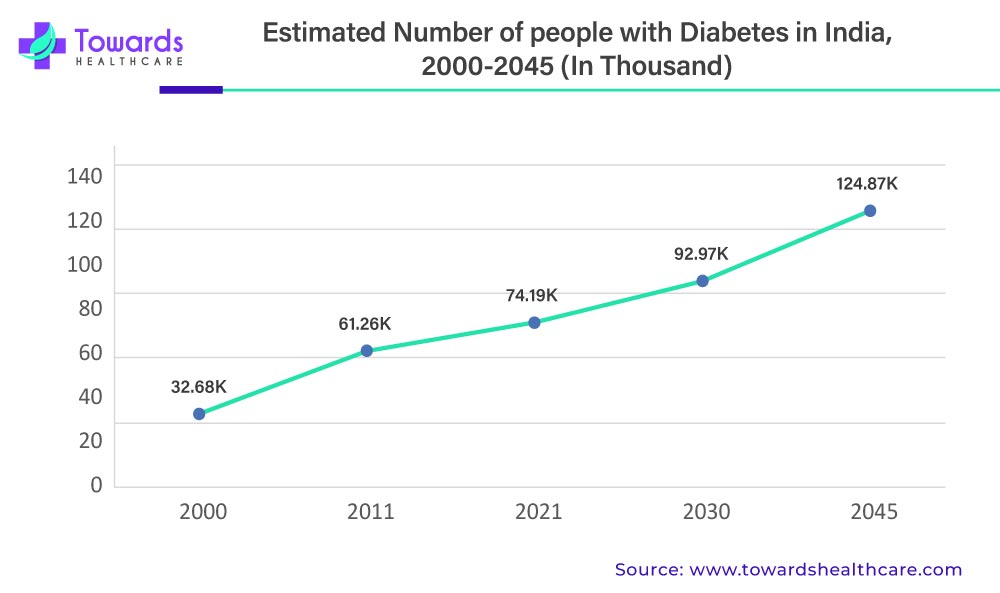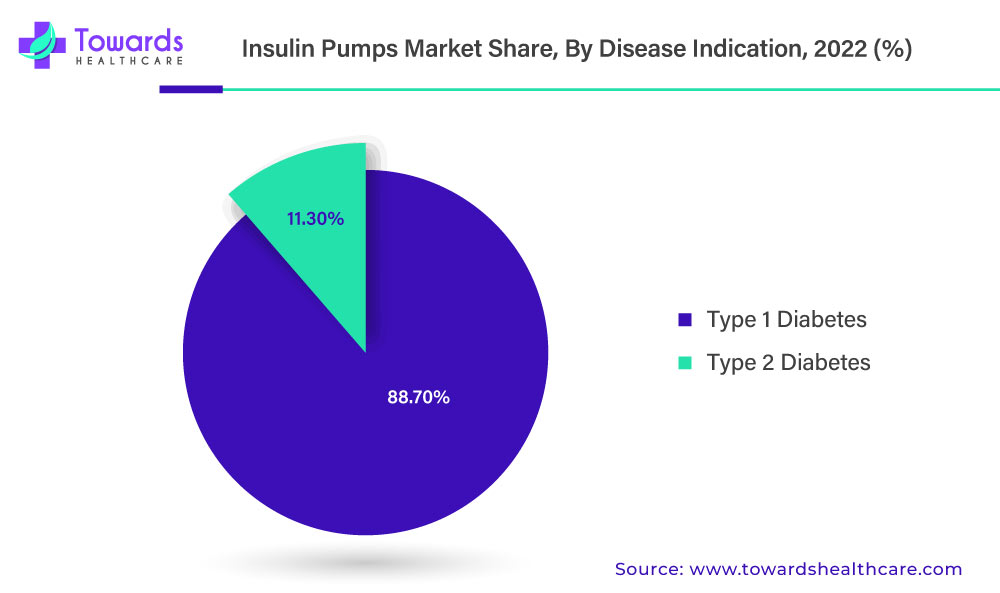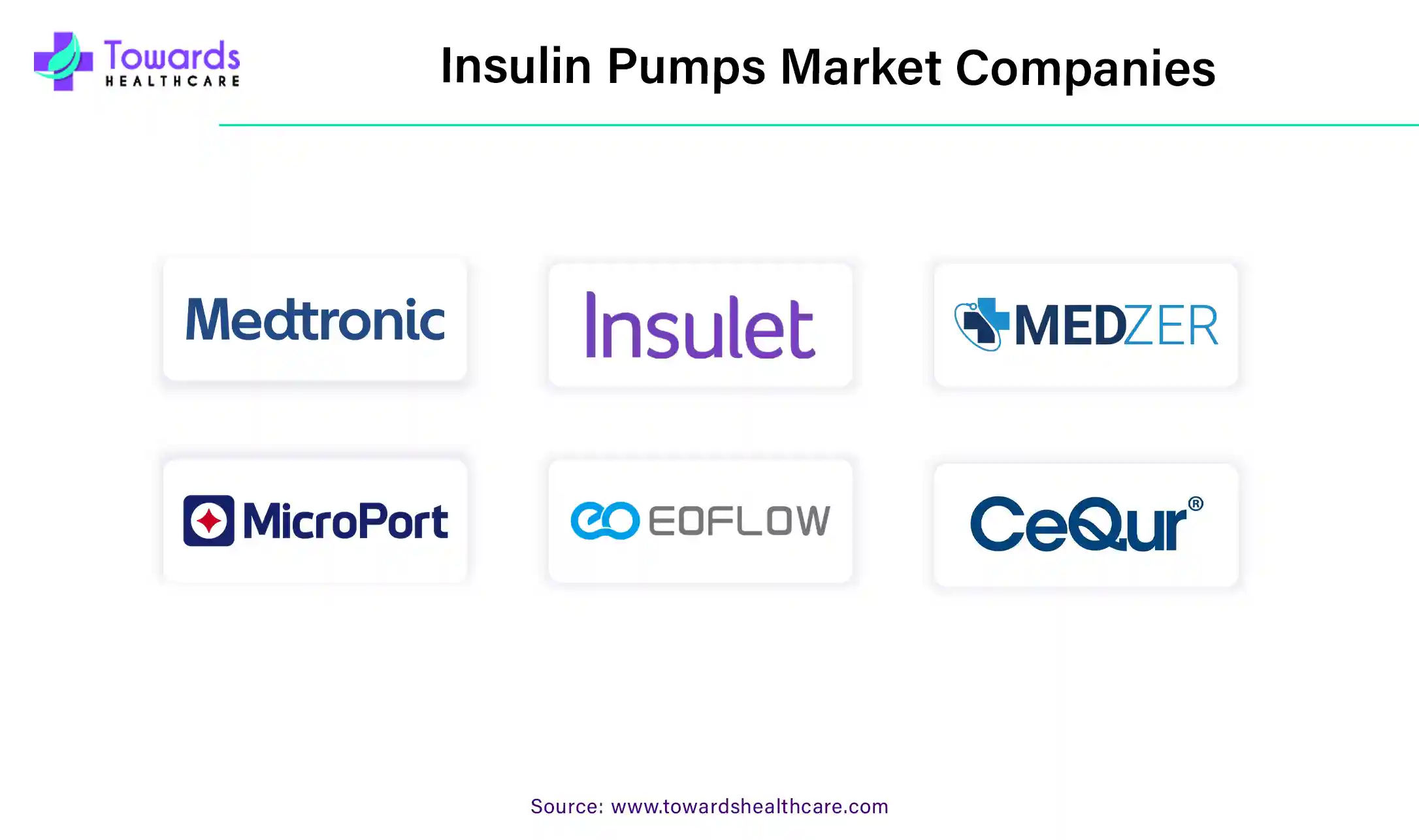December 2025

The insulin pump market is forecast to grow at a CAGR of 9.65%, from USD 6.87 billion in 2024 to USD 17.25 billion by 2034, over the forecast period from 2025 to 2034. The market is expected to gain traction owing to industry players focus on the launch of technologically advanced CGM and insulin pumps.

Artificial intelligence (AI) introduces automation in insulin pumps and controls the delivery of insulin. This enhances accuracy and precision in dose delivery. AI also helps healthcare professionals to provide personalized treatment and adjust dosing according to the patient’s requirements. AI-based sensors detect insulin levels and blood glucose levels in patients. AI-enabled wearable devices help healthcare professionals track real-time data and monitor patients continuously. This helps them to alter treatment strategies, enhancing treatment outcomes. Automation in insulin pumps eliminates the use of needles to inject insulin, enhancing patient experience and increasing medication adherence.
Insulin pumps can make it easier for diabetics to conveniently control their blood sugar levels.
An insulin pump delivers consistent insulin doses all day long to the body. This pump is handy and easy to use, and it is worn externally on a belt, in a pocket, or a pouch. A tiny plastic tube and a needle with a very small diameter connect to the insulin pump. The plastic tube containing the needle is inserted under your skin, then the needle is removed. The plastic tube will remain implanted and connected to the insulin pump for several days. The device can be set to give you insulin depending on your needs and continuously pumps insulin into your body through the tube. At mealtimes, you can administer insulin dosages to yourself using the pump.
In the USA, diabetes mellitus affects an estimated 1 in 10 persons, and both the incidence and obesity rates are on the rise. Diabetes patients are more likely to experience consequences like hospitalizations and hypo-or hyperglycemia, metabolic co-morbidities, or, as we've lately observed, more severe sickness from viruses like SARS-CoV-2. Glycemic targets recommended by the American Diabetes Association during hospitalization aid in enhancing clinical outcomes and minimizing complications. Therefore, it is crucial for the health of individuals with diabetes to maintain euglycemia in both the outpatient and the inpatient setting.
Insulin pump therapy can be a highly effective method for managing diabetes, but certain conditions and situations can contraindicate its use in a hospital setting. One primary contraindication is an impaired level of consciousness, except during short-term anesthesia, as patients must be able to interact with their pump. Similarly, patients who are unable to correctly demonstrate appropriate pump settings pose a risk for incorrect insulin administration. Critical illness requiring intensive care is another contraindication, given the complexity of care required. Psychiatric illnesses that interfere with a patient's ability to self-manage diabetes, including those at risk for suicide, also preclude the use of insulin pumps.
Additionally, acute metabolic complications such as diabetic ketoacidosis and hyperosmolar hyperglycemic state are contraindications, as they require different management strategies. Patients who refuse or are unwilling to participate in self-care, or who lack the necessary pump supplies, are not suitable candidates for pump therapy. Furthermore, the absence of trained healthcare providers, diabetes educators, or diabetes specialists can make the safe management of insulin pumps impossible. Lastly, health care decisions by the medical team may also deem insulin pump therapy inappropriate under certain circumstances.
According to the IDF (International Diabetes Foundation), Atlas, 6.7 million people will die from diabetes worldwide in 2021, and by 2045, the disease will affect 51% more individuals.

In the last ten years, the global Insulin pump market share has advanced significantly and will anticipate that trend to continue exponentially. Even though the number of individuals with diabetes is still growing, the global insulin market has already seen spectacular development.
An insulin pump might be a pleasant reprieve for diabetics who are sick of taking needles. Insulin is necessary for everyone with type 1 diabetes and many people with type 2 diabetes to manage their disease. Using an insulin pump or injecting with a syringe or pen are the two major ways to administer insulin. Insulin pens or several daily injections with syringes are unnecessary with insulin pumps. However, it can be difficult to fully comprehend how insulin pumps operate. As a result, we will go through the many types of insulin pumps as well as each component portion in this post. The insulin pump is a somewhat compact electronic gadget (around the size of a Samsung galaxy s5) that may be simply fastened to a belt or other items of clothing and it is connected to your body by way of an infusion set, which is essentially a skinny tube through which your insulin is administered.
The World Health Organization (WHO) reports that the total number of adults living with diabetes globally is approximately 830 million. According to IDF, the total number of people living with diabetes is projected to increase to 643 million by 2030 and 783 million by 2045. This increases the demand for insulin pumps in a large number of populations.
Major competitors in the global market for insulin pumps are employing a variety of strategies to compete successfully. To deliver technology-driven products, they are increasing their investments in research and development operations. Additionally, partnerships, mergers, acquisitions, and the adoption of cutting-edge technology are some other tactics used by the major players in the global insulin pump market.
The advancement of technology in medical devices used to treat diabetes, such as continuous glucose monitoring (CGM) and insulin pumps has increased and the competition to produce the most advanced products will increase demand for CGM and insulin pumps, creating possibilities for market competitors shortly. The new microneedle patch is designed to test glucose directly in the skin, which is nearly painless because there are no pain-detecting nerve receptors there. Due to the increasing use of diabetes pumps in emerging and developing countries, market participants must focus on the R&D of technologically improved goods and the introduction of new products.

By disease indication, Type 1 diabetes is caused by an autoimmune reaction, in which the body's defined system attacks the insulin-producing beta cells in the pancreas. As a result, the body can no longer produce the insulin it needs and most patients with type 1 diabetes use insulin injections daily and adjust insulin administration based on pre-prandial and postprandial self-monitored blood glucose (SMBG) values.
By disease indication, the type 2 diabetes segment is predicted to witness significant growth in the market over the forecast period. Insulin pumps are beneficial for type 2 diabetes patients with uncontrolled blood glucose levels. The increasing prevalence of type 2 diabetes and growing research and development activities have led to the creation of novel insulin pumps for type 2 diabetes, boosting the segment’s growth. Technological advancements drive the latest innovations in insulin pumps. The latest research found that the use of an automated insulin delivery system improved blood glucose control among type 2 diabetes patients.
By type, the tethered pumps segment held a dominant presence in the insulin pump market in 2024. Tethered pumps are attached to the body using another small tube that connects the cannula. The presence of a display screen to show patients’ data, affordability, and the ability to attach under the clothes makes it a preferable choice for many patients. The advent of advanced technologies can introduce automation in the pumps, enhancing accuracy and precision. The growing demand for personalized care augments the segment’s growth as individuals can apply tailored settings based on their preferences.
By type, the patch pumps segment is expected to grow at the fastest rate in the market during the forecast period of 2024 to 2034. Patch pumps are attached directly to the skin, eliminating the need for a small tube to connect to the cannula. The demand for patch pumps is increasing due to their ease of use. They are generally operated using a wireless remote and deliver insulin through a short needle or tube. Thus, it helps patients to reduce the overdose of insulin and its complications.
By product, the MiniMed segment held the largest share of the insulin pump market in 2024. MiniMed pumps are predominantly preferred due to their technological advancements. They can automate insulin delivery and correct glucose levels every 5 minutes. This helps patients keep continuous track of their progress and enables healthcare professionals in effective clinical decision-making. It operates 24x7 without any fingerpricks, eliminating the risks of needlestick injuries. MiniMed insulin pumps are manufactured by Medtronic and are the most widely used automated insulin delivery system in Europe since their launch.
By product, the tandem segment is anticipated to grow with the highest CAGR in the market during the studied years. Tandem Diabetes Care provides insulin pumps that are up to 38% smaller than other pumps and have a watertight aluminum case. Patients can operate Tandem pumps through smartphone apps, providing personalized solutions. It is based on a closed-loop system that is linked with smartphones. The presence of AI-based sensors and the need to reduce needlestick infections fuel the segment’s growth.
By accessories, the insulin set insertion devices segment led the global market in 2024. Insulin set insertion devices are the most essential part of insulin pumps to allow continuous delivery of insulin from the pumps. These components make the insertion process easier and less painful for users. They also aid in improving accuracy in subcutaneous placement and allow more consistent insulin absorption. All these benefits increase the demand for insulin set insertion devices.
By accessories, the insulin reservoir or cartridges segment is projected to expand rapidly in the market in the coming years. An insulin reservoir refers to the compartment in the insulin pump that stores insulin, and cartridges are replaceable, pre-filled containers that fit into the insulin pump. Lightweight and durable insulin reservoirs are developed through technological advancements and growing research and development activities. These reservoirs or cartridges are developed to reduce the risk of insulin wastage and enhance patient experience.
By end-use, the hospitals segment registered its dominance over the global market in 2024. The segmental growth is attributed to the presence of trained professionals and the availability of advanced and novel devices. Skilled professionals can educate patients about using insulin pumps. The increasing number of hospitalizations due to the rising prevalence of diabetes propels the segment’s growth.
By end-use, the homecare segment is estimated to show the fastest growth over the forecast period. The rising geriatric population increases the demand for home healthcare services. Several companies develop and manufacture portable insulin pumps to be used by patients in the comfort of their homes.
Due to the presence of significant players in the insulin pump industry, North America dominated the market and held the greatest revenue share of around 2024. Additionally, it is anticipated that the market in the region would be driven by the rising incidence of obesity, high treatment costs, technological advancements, and new releases. Due to a rise in the number of elderly people, who are more susceptible to diabetes, Europe is also anticipated to gain a sizable market share throughout the projection period. Additionally, the region's increased demand for insulin pumps is being fuelled by advancements in its healthcare system and the use of cutting-edge medical items.
The market is also driven by favorable regulatory frameworks and government policies. The Food and Drug Administration and Health Canada regulate the approval of novel insulin pumps in the U.S. and Canada. A recent survey shows that around 350,000 to 515,000 people in the U.S. are currently on insulin pump therapy.
North America held the largest share of the insulin pump market. Because of the implementation of advantageous reimbursement regulations for insulin delivery devices in the United States, the area dominated this business. For example, the patient only has to pay 20% of the entire cost of the pump because Medicare Parts A and B cover tubeless and tubed pumps, respectively. Additionally, the region's medical device businesses, such as Tandem and Insulet, will contribute to the market's expansion.
Asia Pacific is a notable player in the insulin pump market due to the high prevalence of diabetes, with India and China accounting for a significant portion of the global diabetic cases. Also, rapid urbanization, economic development, and rising consumer awareness of health and wellness. Furthermore, the region is witnessing a shift towards proactive diabetes care and management, resulting in a greater demand for insulin pumps to control blood glucose levels and improve diabetes self-management.
Due to a rise in the number of elderly people who are more susceptible to diabetes, Europe is also anticipated to gain a sizable market share throughout the projection period. Additionally, the region's increased demand for insulin pumps is being fueled by advancements in its healthcare system and the use of cutting-edge medical items. The rising prevalence of diabetes in Europe increases the demand for insulin pumps. According to the WHO, Europe has the highest burden of type 1 diabetes globally, and it is estimated that 1 in 10 people living in Europe will have diabetes by 2045. Owing to this, the European Union has launched initiatives to combat diabetes in the region. It released the “Blueprint for Action on Diabetes in the European Union by 2030” to develop an EU-wide screening tool and framework. Such steps support the use of insulin pumps in the region.

By Type
By Product
By Accessories
By Disease Indication
By End-Use
By Geography
December 2025
November 2025
November 2025
October 2025